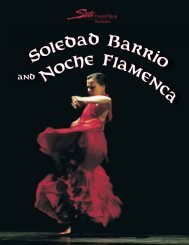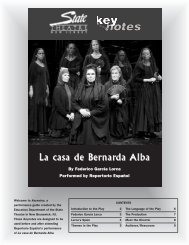Drumline 2011 Keynotes:Layout 1.qxd - State Theatre
Drumline 2011 Keynotes:Layout 1.qxd - State Theatre
Drumline 2011 Keynotes:Layout 1.qxd - State Theatre
Create successful ePaper yourself
Turn your PDF publications into a flip-book with our unique Google optimized e-Paper software.
Brass 9<br />
Instruments in the brass family are all made of metal tubing with a cup-shaped mouthpiece<br />
at one end and a wide opening (called the bell) at the other end. They are played by<br />
buzzing your lips against the mouthpiece to make the air inside the tube vibrate. As<br />
trumpet mutes<br />
with the strings and woodwinds, how high or low a sound the instrument makes is<br />
related to its size; in a brass instrument, the longer the tubing, the lower the sound.<br />
The opening inside the tubing of a brass instrument is known as the bore. The<br />
size and shape of the bore also affects the way the instrument sounds.<br />
Different pitches can be produced on brass instruments in several ways. One way<br />
The<br />
is by changing the amount of tension in the lips and the speed of the vibrating air. Another way is special<br />
to change the length of the tube, most often by pressing one or more valves. The trombone is an mouth position<br />
exception; it changes the length of its tube by an adjustable slide that the player moves in used for playing brass<br />
and out.<br />
and woodwind instruments is<br />
called an EMBOUCHURE<br />
Brass instruments are sometimes played with a mute—a cone-shaped device that is<br />
(AHM-booshure).<br />
inserted into the bell of the instrument to make it play more softly. Muting also changes the<br />
tone quality (basic sound) of the instrument.<br />
trumpet – the highest instrument in the brass family.<br />
It has a brighter tone than the cornet and flugelhorn, which<br />
it closely resembles. The<br />
trumpet is a<br />
versatile<br />
instrument, used<br />
in marching bands,<br />
jazz ensembles, and classical<br />
orchestras.<br />
cornet – a three-valved brass<br />
instrument similar to the<br />
trumpet, but with a<br />
deeper mouthpiece and a<br />
mellower tone. The cornet<br />
is used in military and brass<br />
bands, but not generally in a symphony orchestra.<br />
mellophone – a brass instrument used in marching<br />
bands in place of the French horn. Unlike the French<br />
horn, it has a bell that faces<br />
forward, so the<br />
sound travels in the<br />
direction the player is<br />
marching.<br />
trombone – a brass<br />
instrument that produces different<br />
notes using a slide instead of<br />
valves to change the length of the<br />
tubing. There is a regular (tenor) and<br />
the bass trombone. The bass<br />
version has two valves that allow it to play<br />
lower notes.<br />
euphonium (you-FOnee-um)<br />
- a smaller, higher<br />
relative of the tuba. It can have<br />
three or four valves. There’s a<br />
close relative to the euphonium<br />
called a baritone.<br />
tuba – the largest and lowest<br />
of the brass instruments, used in classical<br />
music and concert bands. They can<br />
have anywhere from three to six<br />
valves. The tuba is twice as long as<br />
the euphonium or baritone. In<br />
fact, if you uncoiled the<br />
tubing of a B-flat tuba, it<br />
would be 18 feet long!
















